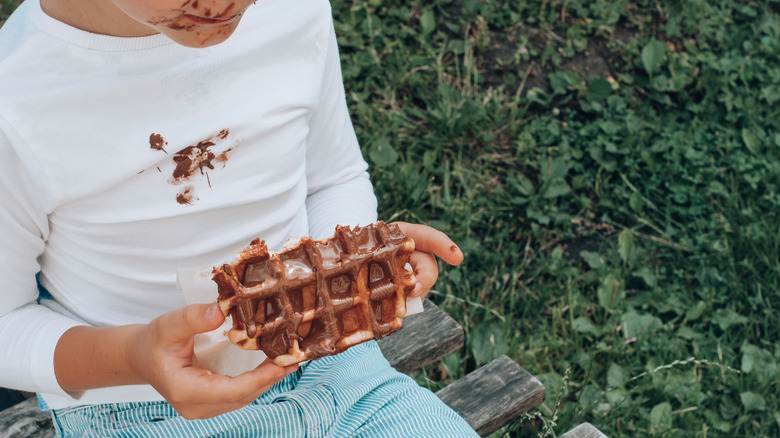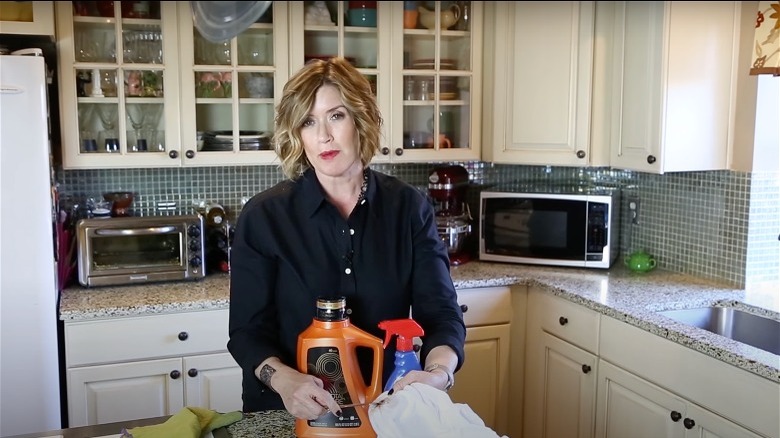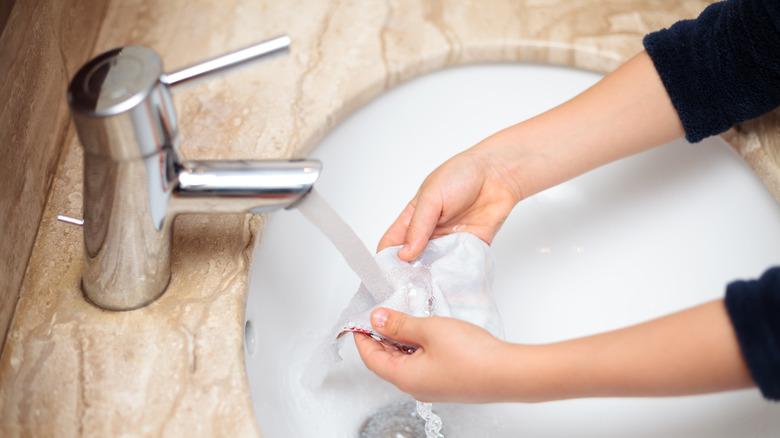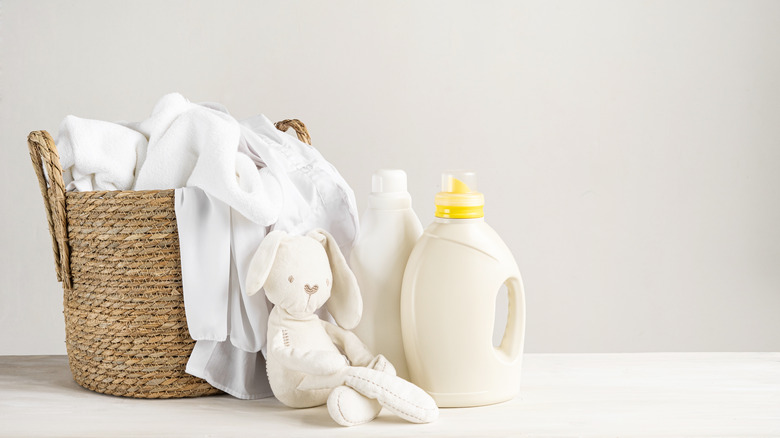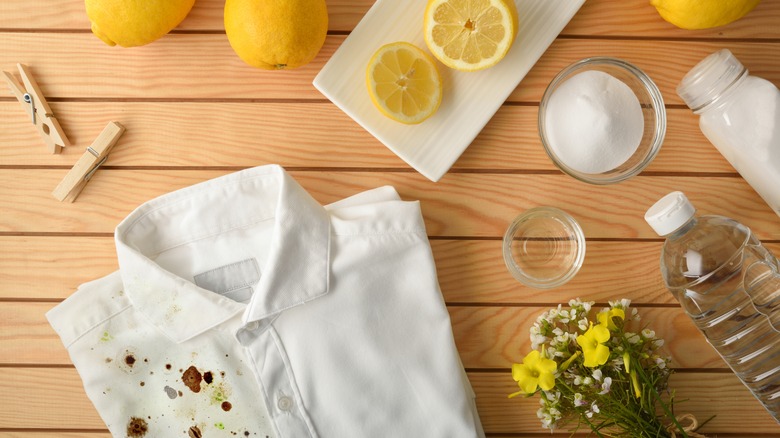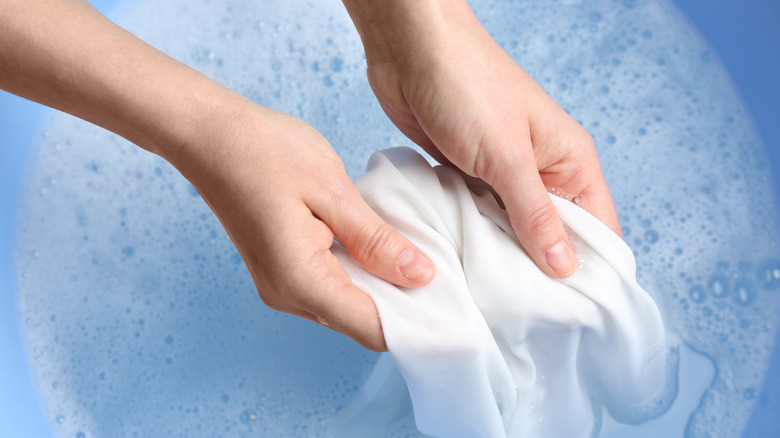Remove Chocolate Stains From Your Clothes By Following These Simple Steps
Food stains are an everyday part of life, especially if you live with young children. In fact, it's sometimes easier to find a piece of clothing with partially-faded sauce dribbles than without. Chocolate stains are among the most notorious, especially when it comes to white fabrics. Your favorite candy bars, cakes, and wintertime mochas are packed with tannins, the compound that gives chocolate its bitter flavor. Tannins can also be found in wine (especially red wine), tea, and coffee — really any food that stains your teeth or embeds itself in living room carpets.
On top of that distinctive brown color, most chocolates also contain oil, making the stains they leave behind all the more difficult to remove. Fortunately, even if chocolate has been marinating on your favorite dress or jacket for the last few weeks, there are ways to make it look as good as new — all you need is a little persistence and access to cold water. Here's how to get started.
Act quickly
The moment you spill that chocolate syrup or notice you've been sitting on a melted Hershey Kiss, it's time to act. Remove the affected garment and toss it in the freezer — yes, the freezer. Solidified chocolate will be easier to scrape off with the dull edge of a knife. If you don't have easy access to a freezer — sometimes the worst stains happen when we're away from home — treat the chocolate with a Tide-To-Go stick or apply a small squirt of hand sanitizer and let it marinate on your way home.
According to Dr. Pete He, the cofounder and chief scientist at Dirty Labs, "What makes chocolate hard [to remove] is the cocoa powder." As he goes on to explain to Apartment Therapy, the high content of calcium, flavonoids, and caffeine (among other stubborn components) means that chocolate stains set when exposed to oxygen (a process known as oxidation).
Rinse underneath cold water
After using the dull edge of a knife to remove whatever chocolate you can, it's time to take it to the sink. Run the stain underneath cold water. Temperature is critical, as heat will only encourage the brown stain to set more deeply into your cotton tee shirt or favorite pair of jeans. Flip the garment around, and rinse from the other side as well, attacking the chocolate from all angles.
Once you've rinsed, apply a dot of detergent or dish soap on the stain, back and front. Let it settle into the fabric for about five to 10 minutes before again rinsing under cold water. In a two-minute how-to, YouTuber Amy Bates, who also owns a professional cleaning business, shows followers how to gently scrub away the stain with her fingers. Next, she recommends spraying the spot with a pre-treater like OxiClean before tossing it in the washing machine.
If the chocolate is particularly stubborn, soak your garment in a cold bath for about 15 minutes before taking on the spot with your fingers or a toothbrush.
White fabrics can benefit from bleach
Though bleach can go a long way in removing stains, it should always be used with care. As you would with a new skincare product or hair dye, start with a spot test. Create a solution of one part chlorine bleach to two parts water and apply a pea-sized drop to a relatively-hidden part of your stained item — the inside of the collar, the cuff of a sleeve, etc. If the fabric changes color as it dries, opting out of bleach entirely is your best bet. However, it's usually safe to bleach white fabrics as long as they're not silk, wool, or spandex. Not only can this lift stains, but bleach is also a deodorizing and disinfecting agent. Look to the garment's label to double-check the washing instructions.
If you don't have chlorine bleach, add hydrogen peroxide to your washing machine's bleach dispenser. Alternatively, create a solution of powdered oxygen bleach and water, letting your chocolate-stained clothes marinate while you sleep. For your safety, don't combine bleach with vinegar or ammonia — certain cleaning products should never be mixed as they create dangerous byproducts.
Consider natural cleaning products
Though bleach is an effective disinfectant, it has harmful environmental consequences, per a study in the Environmental Science and Pollution Research. Especially if the chocolate has left behind a greasy residue, distilled white vinegar is the eco-friendly way to go. As stain removal expert Patric Richardson advises Better by Today, "Use a solution of 50 percent vinegar and 50 percent water on the stain. Apply liberally and then treat with laundry soap and water." Alternatively, a little bit of baking soda can go a long way when it comes to spot-treating stains. Lightly wet the chocolate stain in question with cold water before massaging in a small amount of baking soda with your fingers or a soft-bristled brush — an old, disinfected toothbrush will do the trick. If all else fails, squirt some lemon juice onto the stain.
Finish off the process by throwing it in the washing machine and letting the garment air dry. Fair warning: If the chocolate isn't completely out, a spin in the dryer will make the stain set permanently.
Take it up a notch when targeting old stains
The longer you let a chocolate stain sit, the more difficult it becomes to remove. If you notice a brown chocolate spot that's slipped under the radar, fill up the bottom of your sink or a large bowl with 50% water and 50% vinegar, adding ¼ cup of laundry detergent for good measure. Let the garment sit in the solution while you sleep, scrubbing both sides of the stain with your fingers in the morning. After ringing dry, throw it in the washing machine.
For tough stains, TikTok creator Nicole Jaques (aka @Nicole Jaques) recommends creating your own stain remover using a bottle of hydrogen peroxide, 1 teaspoon of dish soap, and 1 teaspoon of baking soda. Though chocolate is widely considered one of the hardest stains to tackle, be patient. "Even years-old stains have been annihilated with persistence," Marilee Nelson, co-founder of Branch Basics, reassures Reader's Digest. Alternatively, wearing dark clothes will keep you protected from pretty much anything.
